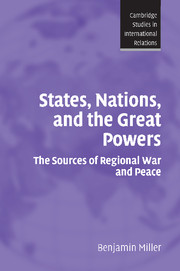Book contents
- Frontmatter
- Contents
- List of figures
- List of tables
- Preface and acknowledgments
- 1 Why some regions are peaceful and others are not
- 2 A theory of regional war and peace
- 3 States, nations, and war
- 4 Explaining the war proneness of the Middle East
- 5 The great powers war and peace in the Middle East
- 6 War and peace in the Balkans: states, nations, and great powers
- 7 The state-to-nation balance and the emergence of peace in South America during the twentieth century
- 8 The emergence of high-level peace in post-1945 Western Europe: nationalism, democracy, hegemony, and regional integration
- 9 Conclusions
- Appendix A Comparative dimensions of the state-to-nation imbalance in the Middle East, the Balkans, South America, and Western Europe in the post-1945 era
- Appendix B Data-file: major armed conflicts/wars by region, type, and modes of great power regional involvement (1945–2004)
- Bibliography
- Index
- Cambridge Studies in International Relations
8 - The emergence of high-level peace in post-1945 Western Europe: nationalism, democracy, hegemony, and regional integration
Published online by Cambridge University Press: 22 September 2009
- Frontmatter
- Contents
- List of figures
- List of tables
- Preface and acknowledgments
- 1 Why some regions are peaceful and others are not
- 2 A theory of regional war and peace
- 3 States, nations, and war
- 4 Explaining the war proneness of the Middle East
- 5 The great powers war and peace in the Middle East
- 6 War and peace in the Balkans: states, nations, and great powers
- 7 The state-to-nation balance and the emergence of peace in South America during the twentieth century
- 8 The emergence of high-level peace in post-1945 Western Europe: nationalism, democracy, hegemony, and regional integration
- 9 Conclusions
- Appendix A Comparative dimensions of the state-to-nation imbalance in the Middle East, the Balkans, South America, and Western Europe in the post-1945 era
- Appendix B Data-file: major armed conflicts/wars by region, type, and modes of great power regional involvement (1945–2004)
- Bibliography
- Index
- Cambridge Studies in International Relations
Summary
This chapter presents a third strategy of regional peacemaking — regional integration — and its application to Western Europe in the era following World War II. This strategy has produced high-level warm peace in the region. The conditions for its success are, however, quite demanding to establish and include both domestic factors — at least a minimal extent of state-to-nation balance and liberalization — and external ones — in particular, a benign great power environment. The external conditions are especially crucial in the early stages of the regional integration when the internal conditions are still evolving. As these conditions (liberalization and state-to-nation balance) reach a high level, however, the role of the external factors becomes less crucial for maintaining the integration and high-level warm peace. Thus, US hegemony, motivated by the Soviet threat common to both the United States and Europe, was a key to the emergence of a cold European peace in its early stages when state-to-nation problems were addressed and democracy was emerging, especially in Germany. Following the resolution of the state-to-nation issues and the consolidation of democracy, regional integration developed and US hegemony became less necessary to maintain the high-level warm West European peace.
- Type
- Chapter
- Information
- States, Nations, and the Great PowersThe Sources of Regional War and Peace, pp. 337 - 368Publisher: Cambridge University PressPrint publication year: 2007

